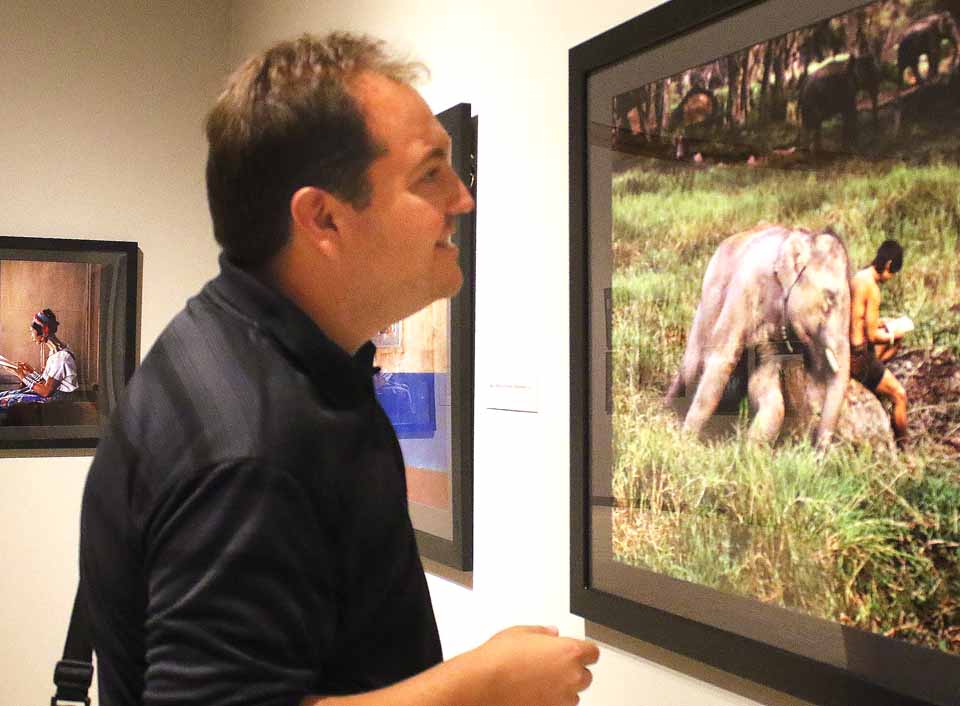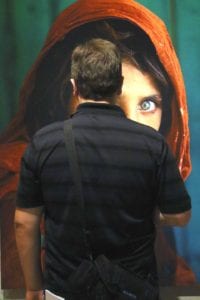PHOTOGRAPHY REVIEW
McCurry Communicates
Calm, Universal Joy

PHOTO EXHIBIT: “Reflections on The World Through His Lens: Steve McCurry Photographs,” Munson Williams Proctor Art Institute, Utica, through Dec. 31.
By IAN AUSTIN • Special to www.AllOTSEGO.com

UTICA – Even if his name doesn’t ring a bell, it is unlikely you have not seen McCurry’s work. Many of the 60 works, spanning three decades of work over six continents, will be easily recognized. Entering the exhibit you are met by the penetrating gaze of his most famous photo, of Sharbat Gula, or, as the world first knew her, “Afghan Girl”.
After she appeared on the June 1985 cover of National Geographic, her photo became as iconic and recognizable as the Mona Lisa. It is considered the most famous portrait in the world, and with good reason. Standing before this piece, you feel like it is not only looking at you, it is looking into you.
Her eyes fixed in an expression that seems to change from fearful, to predatory, to vulnerable and beyond. The color of the eyes mirror the green of her shirt and the wall behind her is contrasted by her red shawl. It is a perfect photograph. It captures the moment that two cultures, alien and strange to each other, are locked in observing the other for the first time. And, like all great art, it makes us reflect and question ourselves and our place in the world.
McCurry’s photographs are living paintings and bridge the gap between photojournalism and fine art, focusing on our shared human experience. The photos – “selected to appeal to the tastes of the Mohawk valley”, a description tells us – show us people, places and moments that seem to have stepped out of a fairy tale. Skin is made of leather, dust and clay. Men pass tea on the outside of a moving train, monks pray at a stone of gold at sunset, and in the forest, a man reads a book alongside his nuzzling elephant. People are red, green and blue. In all of these images we are the observers, and in others we feel the observed.
Walking through the exhibit you can’t help but notice the absence of marketing. No Coca-Cola red, Nickeloedon orange or H&R Block green. The colors in these worlds are not used to sell us things. They simply and completely add to the world with their beauty. And there lies the heart of the show.
This show makes you want to be a better photographer and a better person. You want to paint your house in bright colors and throw out all your black shirts. It makes you reflect yourself and your own culture. It makes you feel like you are seeing a secret but cannot quite decipher its truth. It makes you want to step into the pictures.
The self-awareness that saturates American photography is not present here. These subjects are not preoccupied with looking like they are living a beautiful life, they are living it. These are not people in costumes trying to look cultured for a stunt, agenda or for “likes” on Facebook. None of these people were pressured to smile by a demanding parent, to force idealized emotions instead of those actually there. McCurry captures moments of beauty and harmony in people living their lives instead of having them look like they are living their lives.
Here, beauty is not a brand. It is not perfect hair or skin. It is not having money, or even electricity. Their beauty is not something marketed to all and obtained by a select few. The beauty here is woven throughout life brightly and simply adding to their lives with its presence instead of convincing us we need things to obtain it. Poverty is evident, but there seems to be an absence of want. Here, traditions, spirituality, solitude and company project a harmony present in all things. Their peace and harmony comes from within and from the people, animals and places around them, not from some corporation.
The people in these photos live their lives, for better or worse, taking pride in their work, following ancient rituals, enjoying the company of animals, and surrounding themselves in color, patterns and nature. The constant American undercurrent of suffering towards some unobtainable happiness is not seen, instead replaced by a quiet calm and moments of non-purchased calm or universal joy.
You leave wondering why the most boldly patterned and decorated clothing you wear is usually under your clothes. You leave wanting to paint your world in bright colors. You leave feeling you have been privileged to look into these worlds, as well as a slight feeling like you have been watched. You leave with the feeling the pictures have watched you.
These are the types of photographs that inspire us to become photographers, or to travel the world. They inspire us to action, or to make changes in ourselves. They awe, inspire, baffle and enchant. These are the photos we all wish we could take, and the genius of McCurry is that he makes it look so easy.
A saying on the wall that sums it up perfectly: “It is his intuitive understanding of light, color, composition and timing that move his photos from pure documentary to the sublime. His images allow viewers to explore the world.”
Ian Austin of Oneonta is chief photographer for the Hometown Oneonta and The Freeman’s Journal newspapers, and for www.allotsego.com

